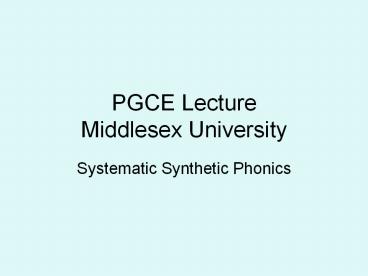PGCE Lecture Middlesex University - PowerPoint PPT Presentation
1 / 20
Title:
PGCE Lecture Middlesex University
Description:
PGCE Lecture Middlesex University Systematic Synthetic Phonics What is synthetic phonics? It refers to an approach to the teaching of reading in which the phonemes ... – PowerPoint PPT presentation
Number of Views:124
Avg rating:3.0/5.0
Title: PGCE Lecture Middlesex University
1
PGCE LectureMiddlesex University
- Systematic Synthetic Phonics
2
The Rose Report independent review of the
teaching of early reading2006
CONTEXT
3
- Recommendations
- High quality phonic work as the
- first approach to reading.
- To foster speaking and listening skills.
- To blend in order left to right through
- the word.
- HFW discuss the tricky bit
There are statutory amendments to the National
Curriculum in En2 reading and the EYFS
4
What is synthetic phonics?
- It refers to an approach to the teaching of
reading in which the phonemes (sounds) associated
with particular graphemes (letters) are
pronounced in isolation and blended together
(synthesised).
5
What is systematic phonics instruction?
- Phonics instruction is systematic when all the
major grapheme-phoneme correspondences are taught
and they are covered in a clearly defined
sequence. - Review into the Teaching of Early Reading
- (2006 17)
6
(No Transcript)
7
Rose report key recommendations
- The teaching of early reading should be
contextualised within a broad and rich - multi-sensory language curriculum, i.e
- Varied opportunities to listen and talk
- Quality reading experiences, i.e. being read to,
sharing or independently reading from a range of
reading materials, e.g. poetry, narrative,
non-fiction. - A holistic view of learning that makes sensible
links between subject areas. - Appropriate use of ICT.
8
Background
- Rose Review in the Teaching of Early Reading 2006
- Changes in the statutory requirements of National
Curriculum and Early Years Foundation Stage to
reflect new focus on phonics - Letters and Sounds resources sent to all schools
2007 - Emphasis on systematic phonics teaching (
synthetic regarded as best approach) - Increasing attention on systematic synthetic
phonics (SSP) as main teaching approach in early
reading 2010 - Governments decision on a phonics screening
check for 6 year olds 2010 ( pilot 2011 and
rolled out 2012) - Change in criteria for phonics programmes 2010
now includes decodable books - New standards for Teachers (2012) includes
ability to demonstrate a clear understanding of
SSP.
9
The English language has 44 phonemesand 26
letters
- A phoneme can be represented by one or more
letters. E.g. t kn igh - The same phoneme can be represented (spelt) in
more than one way. E.g. rain may lake - The same grapheme may represent more than one
phoneme .E.g mean deaf field tried
10
Alphabetic code Phonemes are represented by
graphemes
The skill of Blending (synthesising) READING
The skill of Segmenting SPELLING
C a t cat
Cat c a t
Blending and segmenting are reversible processes
11
The four principles of SSP
- Learn grapheme/phoneme (letter/ sound)
correspondences (the alphabetic code) in a
clearly defined, incremental sequence (GPC) - Apply the highly important skill of blending
(synthesising) phonemes, in order, all through a
word to read it - Apply the skills of segmenting words into their
constituent phonemes to spell - Blending and segmenting are reversible processes.
11
12
A segmenting activity
- Segment these words into their constituent
phonemes - shelf
- dress
- thing
- boat
- eight
Answers on next slide
13
Segmenting
WORD PHONEMES PHONEMES PHONEMES PHONEMES PHONEMES PHONEMES
shelf sh e l f
dress d r e ss
thing th i ng
boat b oa t
eight eigh t
14
Phonic TerminologyThese terms can be used with
children
- Phoneme
- Grapheme
- Digraph
- Split digraph
- Trigraph
- Blending
- Segmenting
15
Support Resources
- UniHub University resources ( Rose Review,
planning templates and examples, Letters and
Sounds Handbook, observation prompts) - Websites ( National Archives, )
- Software ( Multimedia, Splash)
16
A phonics quiz
- What is a phoneme?
- What is oral blending?
- What is a digraph/ Give an example.
- How many ways to spell the /ie/ sound?
- What is a grapheme?
- What is a tricky word
- What do the letters GPC mean?
17
Phonic Resource
Any programme that meets the criteria for high
quality phonic work Jolly Phonics Read Write Inc
18
Phase 1 in Letters and SoundsSummary
- Distinguishing between different sounds e.g.
environment, instruments, body percussion,
speech. - Awareness and experimenting with speech sounds
and words e.g. alliteration and rhymes. - Beginning to orally blend and segment phonemes.
19
Phase 2 in Letters and SoundsSummary
- The start of systematic phonic work.
- Introduction of the GPCs (grapheme-phoneme
correspondences) - 19 letters in 5 sets over 6 weeks
- 1st set is s a t p
- Teaching a letter hear it , say it and write
it. - Blending and segmenting VC and CVC words.
- Read high frequency words HFW
- Also introduce two syllable words and captions
20
Phonological awareness






























![Dr Babasaheb Ambedkar Open University - [BAOU], Ahmedabad PowerPoint PPT Presentation](https://s3.amazonaws.com/images.powershow.com/9654610.th0.jpg?_=20210831093)
